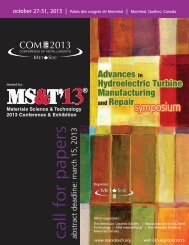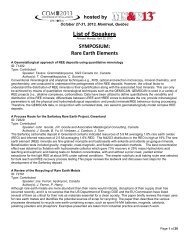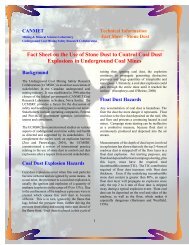List of Speakers SYMPOSIUM: Light Metals for Transportation
List of Speakers SYMPOSIUM: Light Metals for Transportation
List of Speakers SYMPOSIUM: Light Metals for Transportation
You also want an ePaper? Increase the reach of your titles
YUMPU automatically turns print PDFs into web optimized ePapers that Google loves.
hosted byOctober 27-31, 2013, Montreal, Quebec<strong>List</strong> <strong>of</strong> <strong>Speakers</strong>Revised: Monday, April 22, 2013<strong>SYMPOSIUM</strong>:<strong>Light</strong> <strong>Metals</strong> <strong>for</strong> <strong>Transportation</strong>Canadian Metallurgical Quarterly (CMQ):Topic Distributions In The First 50 Years 1961-2011ID: 71190Type: ContributedSpeaker: Hugh McQueen, Concordia University, CanadaAuthor(s): H. McQueen, N. KilingiFor insight into Metallurgical Society CIM activities during the past half century, the subjects published in the CMQ wereclassified into 40 topics as presented in tables at 5 year intervals; graphs compare the relative changes over the years.Hot workability <strong>of</strong> Al alloys is charted in comparison to Mg alloys and steels. The significant groups started from propertieswith divisions <strong>for</strong> microstructural, physical, thermo dynamic and mechanical; the last has more details <strong>for</strong> hot workability(author’s specialty): Al alloys, C/HSLA, tool, stainless steels, Cu and Ni alloys, and hexagonal metals. Secondaryprocessing includes hot working, cold working / annealing, casting, welding, and heat treatment. Extractive metallurgyincludes steel making, smelting / non-ferrous, hydro-metallurgy and mineral dressing / flotation. There are headings als<strong>of</strong>or environment, energy and history as well as ceramics, polymers and semi-conductors. For hot working, there is somediscussion <strong>of</strong> Met. Soc. Proceedings, especially <strong>Light</strong> <strong>Metals</strong> volumesCharacterisation <strong>of</strong> the Creep Behaviour <strong>of</strong> the Cathode Steel Bar Connector at High Temperatures and LowStress LevelsID: 72366Type: ContributedSpeaker: Femi Fakoya, REGAL, Universite Laval, CanadaAuthor(s): F. Fakoya, D. Picard, H. Alamdari, M. FafardMechanical properties <strong>of</strong> carbon steel at high temperatures, low stress levels are important and their per<strong>for</strong>mance inapplications such as aluminium production cell, power plants and nuclear reactor plants are still not well understood.Hence, an experimental program was carried out to investigate the mechanical properties <strong>of</strong> carbon steel in thisaggressive environment. The mechanical properties <strong>of</strong> carbon steel in austenite temperature region and particularly lowstress levels have been investigated in relation to its creep behaviour in compression with an eye towardscharacterisation. The mechanical properties were obtained under a steady state compression test at ambient and hightemperatures up to 950oC. The time dependent mechanical properties were also obtained usingcompression creep tests at constant low stresses (0.5 – 1 MPa) and constant high temperatures (800–950oC). A stress required to activate creep at high temperature was identified and minimum temperaturerequired <strong>for</strong> activating creep de<strong>for</strong>mation was also determined.Characterization <strong>of</strong> Fir-Tree Zones in AA1050 DC Cast IngotID: 71822Type: ContributedSpeaker: Zhan Zhang, University <strong>of</strong> Quebec at Chicoutimi, CanadaAuthor(s): Z. Zhang, G. Li, X. ChenFir-tree zones, caused by transition <strong>of</strong> various Fe-bearing intermetallics in cast microstructure, are one <strong>of</strong> mostencountered defects in aluminum direct chill (DC) cast ingots, which could result in serious surface problems <strong>for</strong> highquality surface appearance products. However, the <strong>for</strong>mation mechanism <strong>of</strong> fir-tree zones has not been well understoodbecause <strong>of</strong> great challenges on identification and quantification <strong>of</strong> the Fe-bearing intermetallics. Using combination <strong>of</strong>electron backscattered diffraction, energy dispersive spectrum and image analysis techniques, the transition <strong>of</strong> Fe-bearingintermetallics throughout the fir-tree zones <strong>of</strong> AA1050 DC ingot were quantitatively investigated. It was found that severalintermetallics such as AlmFe, a-AlFeSi, Al6Fe, Al3Fe and Ni-containing (AlFeNi) phases co-existed in the zones. Typicalintermetallics morphology in the zones was revealed using deep-etching technique. The volume fraction and distributionPage 2 <strong>of</strong> 17


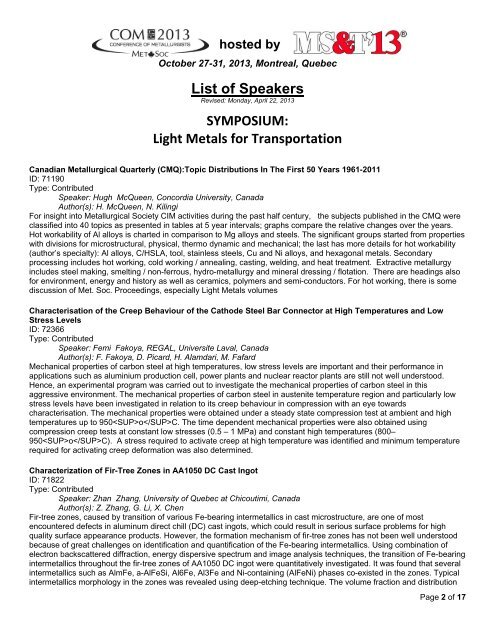

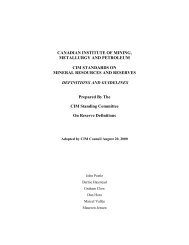
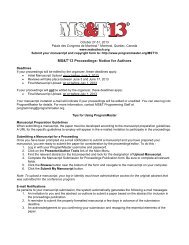


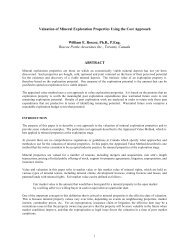
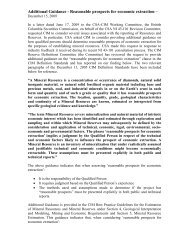
![Richard Wright - NORWEST Corporation [PDF]](https://img.yumpu.com/34320526/1/190x245/richard-wright-norwest-corporation-pdf.jpg?quality=85)
